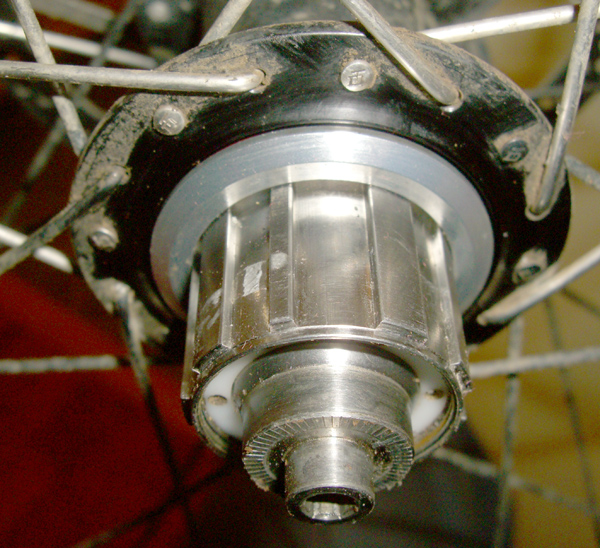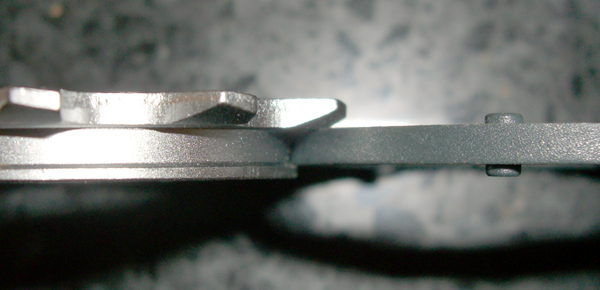Six Speed MTB
After running a single speed mountain bike in Marin, CA for the past 4 months, I have decided that it may not be for me. It is a very interesting way to ride, but it really leaves me wanting when the terrain gets fairly steep and soft, and when the downhill gets up to real speeds. I figure that I could use a little bit of range from center to make things a little more fun while keeping my drive train solid for winter riding.
While practicing for the Sea Otter Downhill race in 2006, I got to talking to a pro rider that was running a four or six speed setup. I realized that I really had to be a little more creative when thinking about what is possible when setting up a bike for specific targets. That minimal gearing setup has stuck in the back of my mind untill now. It may be perfect for what I need.
Contents
Why 1X6 instead of 1X9
Like most things drivetrain, it comes down to chain line. When I am helping a new rider learn to shift properly, one key rule that I give them is to keep their chain as straight as possible. A straight chain is one of the most efficient drive systems available for a bicycle. A straight chain is one of the factors that make a single speed bike feel quite like it does.
For this reason, a 27-speed mountain bike really only has about 12 or 15 correct gear choices. Other choices may be possible, but result in such a horrible chain line as to be inefficent or destructive. A 1X9 is really just a 5 speed with 4 additional gears that are completely destructive or inefficent to use.
So, we go down to 1X6. A 1X5 is probably better in terms of pure theory, but since I can fit six speeds on my hub, I am going to try it. With either of these setups, the chain is only shifted between 2 or 3 cogs from center, keeping a fairly efficent chain line. This also keeps chain wear down to a minimum.
The Hub
While any cassette hub can be used for doing this, one hub is really better than all the rest. The Hadley Single Speed Disc hub. This is one of the finest hubs availble in terms of quality and configurations, but it has some other things going for it that are perfect for this project.
- Wider flanges than a standard cassette hub. This makes the wheel laterally stronger.
- Zero dish. Since the flanges are centered on the hub, the spokes will be evenly tensioned. This is good.
- Long cassete body. Given that the flange width is maximized, by also maximizing the cassette body length gives us the maximum possibilities for gearing.
I had done some research about how many gears I could fit on this hub before I spent the money on parts. I was pretty positive that I would be able to fit five speeds on this hub. I even spoke directly with Mike Hadley, the hubs namesake. He said five. When I went to assemble my cassette on the hub, I found that I could in fact fit six, 9-speed spaced, 9-speed width cogs on the cassette.
8 speed vs. 9 speed
One of the decisions that needed to be made when assembling the needed parts for this project was weather it would be a 8-speed or 9-speed chained and spaced setup.
The advantage to an 8-speed configuration is that the chain and sprockets are slightly more robust that with the nine. Shifting tends to be slightly better as well since it takes a lot more disruption to derail the chain on an 8 speed setup.
The advantage to a 9-speed configuration is that 9-speed chains and sprockets are far more available than 8-speed parts. This applys to shifters as well, a very important consideration.
In the end, I decided to go with a 9-speed configuraion since I try to source my bikes parts so that I can go into any bike store anywhere and get replacement parts in stock and cheap. I will use a Dura-Ace 9 speed chain.
Cassette Info Brand Speed Cog, Ctr. to Ctr. Cog, Thickness Spacer Thickness Spacer ID Shimano 10 3.95mm 1.60mm 2.35mm 33.6mm Shimano 9 4.34mm 1.78mm 2.56mm 33.6mm SRAM 9 4.34mm 1.80mm 2.54mm 33.6mm Shimano 8 4.80mm 1.80mm 3.00mm 33.6mm SRAM 8 4.80mm 1.80mm 2.54mm 33.6mm
Chain Info Brand Speed Size Pin Width Roller Width Roller Diameter Shimano 10 1/2" x 11/128" 5.9mm ??mm 7.75mm Shimano 9 1/2" x 11/128" 6.6mm 2.2mm 7.75mm SRAM 9 1/2" x 11/128" 6.65mm 2.2mm 7.75mm Shimano 7/8 IG 1/2" x 3/32" 7.1mm 2.2mm 7.75mm Shimano 7/8 HG 1/2" x 3/32" 7.3mm 2.2mm 7.75mm SRAM 8 1/2" x 3/32" 7.1mm 2.2mm 7.75mm SRAM 7 1/2" x 3/32" 6.8mm 2.2mm 7.75mm
Building the cassette
Do not attempt to make a cassette using a stack of single speed cogs. That is not only expensive, but will result in poor shifting performance. Modern cassetts have a complicated array of ramps and shapes to help the chain move about the cluster. When we make a 6 speed cassette, we will have larger jumps between gears, increasing our need for shifting help.
It is best to canibalize a constructed cassette for this. When choosing what cassettes to canibalize for this project, you mainly need to focus on whether it is 8 or 9 speed and that it is possible to break apart. Lots of the higher end cassets will be built around a carrier, these will not be suitable.
If you take some time and do a little math and some thinking, you can get a good idea of what gears or range you will need for your cassette. Although I did do this, in the end, I built the widest range I could given my six choices.
Remember that rear derailure choice defines the largest possible cog on the cassette. Since I am building with a Shimano 105 short cage derailure, I needed to keep my max sprocket to 27 teeth or less.
My initial cassette choice is 11,14,17,20,23,26. These will combine with a 34 tooth front sprocket to, hopefully, make some good usable gearing.
I broke two SRAM PG-970 cassettes apart to make this stack. 11/13/15/17/20/23/26/30/34 & 11/12/14/16/18/21/24/28/32. The cassette is broken apart by removing the 1.5mm allen at the back. A Shimano cassette may require griding or drilling out a few rivets.
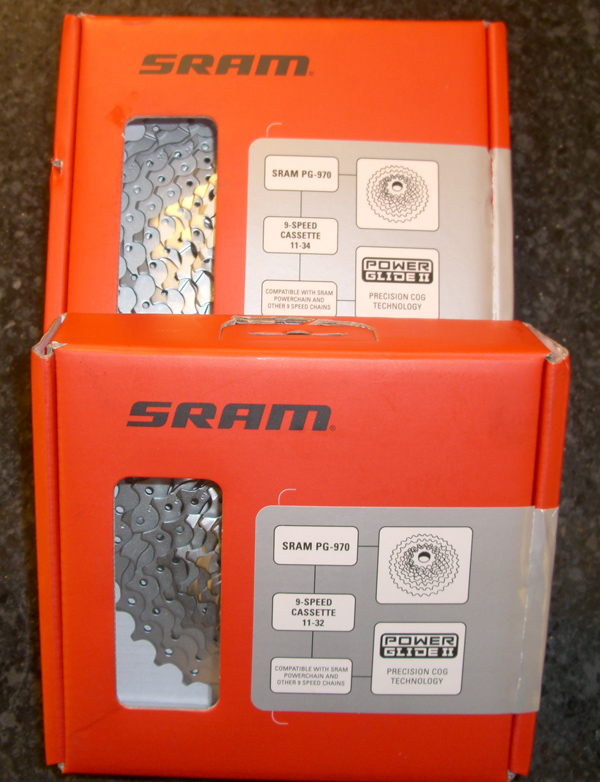
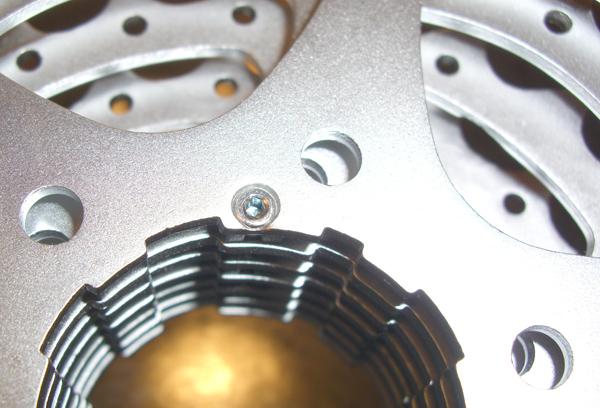
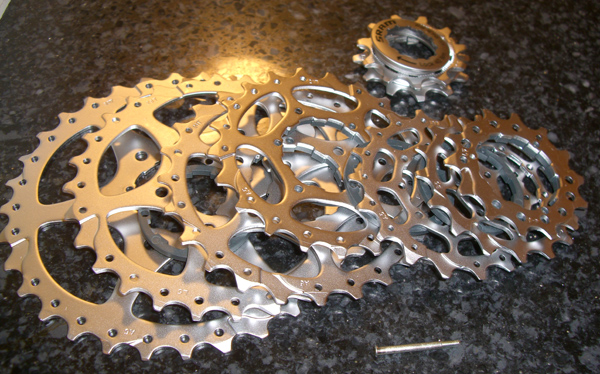
To use the 11 tooth cog on this cassette, about 0.036" needs to be surface ground from its integrated expanded spacer. This is because I am not using the cog that initially mated to this one. Once this is done, I can shim the cassette into postion for the best chain line and away from the spokes.
This is what the cassette looks like (11 tooth cog not modified yet):
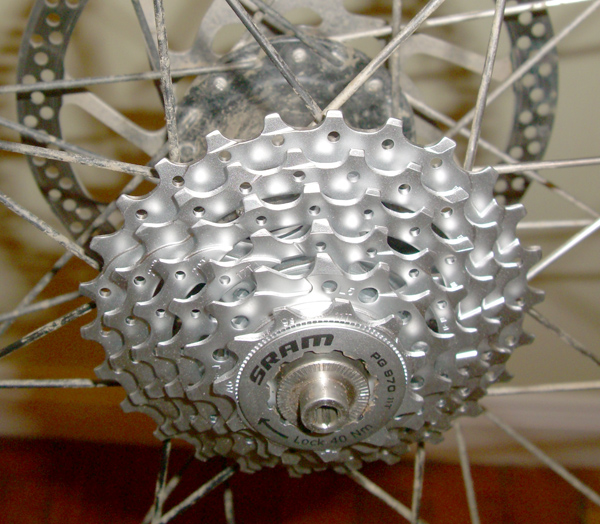
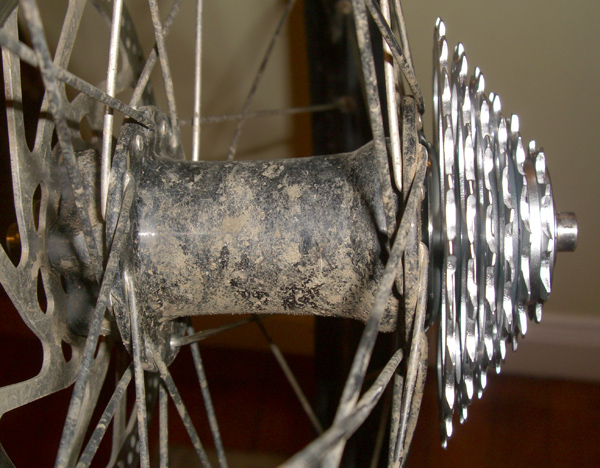
Shifters
Shifters define the indexing of the rear derailure. Your shifter must match your choice of 8 or 9-speeds.
Just for fun, I figured that I would try a Shimano Saint (SL-M800) shifter for this project.
Derailures
While any standard MTB derailure will work, I am choosing to run a short cage derailure since I will have only one front ring. The road rear derailures by shimano work just fine in the dirt. Shimano 105 Rear Derailleur RD-5600-SS
- Option
- If I had gone the SRAM route, I would have chosen the new 2007 X-9 Short Cage derailure.
- Important note: SRAM road parts are not cross compatable with the off road line. Do not try to use a SRAM road rear derailure.
Chain Guides
A chain guide may or may not be necessary to keep the chain in place up front. A riding test will confirm what has to be done. This may be an important issue.
Chain Line
Standard front chain lines for 3 ring mtb are either 47.5mm or 50mm. Then for road (2 ring), track, and bmx, chainline is generally 43.5mm.
I endeded up with ????
The rear chainline was then made as close as possible to this.
Results
Project is not complete.
